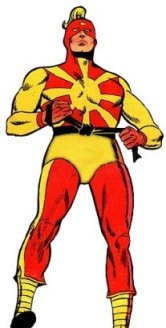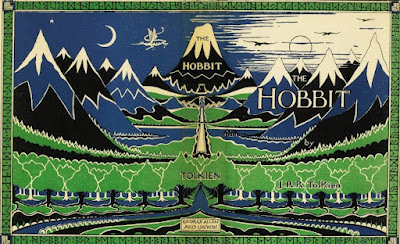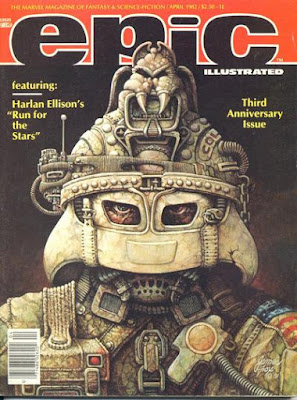Below are three review I wrote over the years for the three installments of The Hobbit as directed by Peter Jackson. I've tweaked them a bit for the sake of some consistency, but for the most part I've left them as they were originally presented. When my opinion has changed, I've indicated.
December 2012 - An Unexpected Journey
I went to see The Hobbit - An Unexpected Journey yesterday morning. Usually Sunday morn is a dandy time to catch flicks as it offers quiet reasonably empty theaters. Not yesterday. Despite a 10 AM start, there and the fact I went to the mundane 2-D presentation, there were still over a one hundred folks enjoying the latest trip to Hobbiton and beyond with me.
I have to confess going this time was more a chore than a joy. I was giddy to see the first of the Peter Jackson adaptations over a decade ago, going opening night and braving giant crowds. This time, I mostly wanted to see it before reviews spoiled it. I've not been happy since I learned there are going to be three of these things. I fear we're going to see a trio of bloated narratives, dragging in all manner of off the rack material. A scrupulous adaptation of the Tolkien classic would make for two reasonably sized flicks and would add nicely to what the New Zealanders have already accomplished.
Hobbiton is beautifully rendered, and it was scrumptious to visit this exceedingly cool mythical hamlet again. The scenes of the group tramping across the countryside astride their ponies were beautifully done, really communicating the essence of Tolkien for me. The balance between the unusual and the beautifully mundane is perfectly balanced in these scenes. Riddles in the Dark is outstanding, precisely true to Tolkien as I remember it at least. I'm not a huge Gollum fan in these movies, finding him at times very tedious, but he works here as well as he ever has. The technology supports the performance here wonderfully. Likewise with the Wargs which look really menacing.
It's not the filmmakers' fault, but thirteen dwarves are a challenge for anyone. It is a downright "avalanche" of dwarves. There's no doubt in my mind that if Tolkien's book was not so beloved, a typical adaptation would lower the number of dwarves to six or seven at best. But stuck with the original mob, Jackson and company try to make them distinctive, though we fail to get proper introductions to many. At least they are visually distinctive. It's almost impossible though to keep track.
Unfortunately for this movie and I fear for the franchise, the development of "performance-capture" has "captured" this movie. For me the triumph of the earlier movies was that it made the world of Tolkien's Middle Earth real. It grounded the fantasy into a place and time, adding some blood and thunder to the proceedings. But that alas is lost in this tale which all too quickly reduces itself to a video game as animated figures cavort and crawl across the screen. The action is sweeping and dashes along spritely, almost too quickly to process. The damage the heroes suffer is epic and alas cartoonish. The realism of the early epics is lost, much to detriment of the heart of the project. The scene with Gandalf, Saruman, Elrond, and Galadriel in the middle of the movie seems downright quaint as we have four normal sized people in a regular real-world room talking. This scene actually jars a bit since so much of the movie before and even more so after is overwrought with special effects. They're exquisitely done I'm sure, but they undermine the reality of the experience for me.
All in all, I'd give first Hobbit movie a middling to low grade. It's got some very strong stuff. A good Bilbo, a great Gandalf, some few interesting dwarves, and some beautiful countryside. But the movie is its own worst enemy ironically since it is technology that is sundering the essence of Middle Earth, the very thing Tolkien moaned about so vehemently in his lifetime.
December 2013 - The Desolation of Smaug
I was a bit underwhelmed by the first installment of Peter Jackson's epic adaptation of J.R.R. Tolkien's The Hobbit, a yarn about the eponymous wandering Hobbit and thirteen dwarves seeking ancient treasure. Not because it wasn't impressive, but because to my weary eye it came across as more of an animated event than a real- life movie. So, I didn't rush out to see the second installment this past holiday season. I thought I'd wait for the inevitable DVD and just watch it then. That's a far cry from the burning enthusiasm I had for the original Jackson film trilogy which I anticipated with a ripe eagerness.
But with time on my hands and nice warming temperatures and a dry day, I thought I'd take it in at the local discount cinema. With soda and popcorn (each costing more than my ticket) in hand I settled into the well-used theater alongside a few others and watched what surprisingly turned out to be a rousing movie event. The computer-generated elements were surely in evidence, but somehow seemed less apparent to my eye and so failed to draw me out of the adventure which picked up where last year's first installment left off.
Bilbo Baggins and his dwarf companions encounter Beorn the shape-changer, enter the horrible Mirkwood forest and confront the rather grim elves within, and make their way to Laketown, the domain of men at the foot of the Misty Mountain where Smaug came to drive the dwarves out generations before. They raid the dark halls and wake the dragon, a dangerous thing to do.
For a movie which lasts nearly three hours I found time flying by remarkably swiftly and was actually startled when the story ended, leaving me hanging for many months before I can discover the end. Of course, we all know how it will end, but how we'll get there is the challenge Jackson has before him. He's created a rousing thrill-ride with this installment, less dependent on its Tolkien source material, but which does a goodly job of linking this tale to the earlier trilogy.
Good show indeed. I'm eager to see the end now, very eager indeed.
Well, that took long enough. Last week I went to see The Hobbit - The Battle of The Five Armies. It was a long and visually rich film experience, but alas not one that succeeds as it ought. For the first time, I saw one of these new-fangled 3-D movies and frankly while it's a neat curiosity the texture of the movie seemed more like the flatness often translated on video tape; the luster of film was lost and along with it some of the essence of movie magic.
Anyone curious enough to read this review will be familiar with the story and likely the film series which began a few years ago with The Hobbit - An Unexpected Journey which re-introduced us to the realms of Middle Earth as first designed by J.R.R. Tolkien so many decades ago. We meet a youthful Bilbo Baggins who is drawn into a wild and weird adventure by the wizard Gandalf as he joins a company of dwarves who want to reclaim their lost kingdom from the deadly dragon Smaug. In the second film The Hobbit - The Desolation of Smaug we finally get to the Misty Mountain and Bilbo meets the charming but deadly Smaug and the dwarves, led by the quixotic royal heir Thorin Oakenshield fight hard to reclaim their kingdom deep inside the mountain, but in the end, they unleash the dragon who flies to destroy the nearby human settlement of Lake Town.
The Hobbit - The Battle of the Five Armies begins with the struggle to bring down Smaug. I'm not ruining too much by saying this happens before the credits have properly finished rolling and that of course points glaringly to the greatest deficiency in this film series...it's just plain too long.
In a somewhat disdainful attempt to extract as much money from Tolkien fans as possible the decision was made rather late in the production to make the movie into three parts deviating from the original scheme to do only two movies. Given the source material, two seems ample and sadly if the original plan had been followed, I don't doubt we'd have had two very tight films which resonated strongly in the imagination. Alas what we have now are three movies with a host of virtues, but which tumble along with overlong and somewhat vapid action sequences which only serve to weary the viewer and drain the characters of their verisimilitude. No dwarf and no human could survive the falls these characters take over the course of the three movies, and that's a pity in the sense we lose interest in their physical fates.
In my earlier reviews of the first two movies, I decried the tendency for the action sequences to have a video game feel and regrettably this third one has even more of that sense. One fatal flaw in this concoction is the utter failure in creating a villain with which the audience can have any connection. Azog is a cartoon from the get-go a creature right out of a superhero comic who feels out of place in Middle Earth and is rendered so heavily that we can hardly ever detect any real human behind the portrayal.
It's all so tiring in the final analysis.
And Now for General Comments
And that seems to me to be the nut. For all the blather, most of it I'm sure exceedingly earnest, the director and his team do not trust the source material. In an effort to mostly recreate the highly successful Lord of the Rings trilogy nearly beat for beat they constantly overheat the story elements of The Hobbit to accommodate that understandable but ultimately self-defeating goal.
We are saddled with a forbidden romance between races which never reaches a boil, we are given a journey through the shadows of a dark goblin-infested realm which becomes a frenetic footrace against the enemy but almost never achieves any sense of true peril, we are given a finale which as promised in the title features five armies, but alas armies so vast and clearly digitized that they lack the ability to draw out our compassion. The sub-plot involving Gol Guldur and the Necromancer and his minions searching for the rings makes perfect sense when the flick is seen as a precursor to the later LoTR, but within the immediate story needs of The Hobbit they become distractions, as spectacular as they are.
Where the movies most often succeed is in those elements of the story which are demanded by the source material and cannot by and large be tampered with. The encounter by Bilbo with Gollum is tense and properly paced, and his later verbal joust with Smaug is the highlight of all three movies. Sadly, the Hobbit himself gets lost in this last movie, despite several attempts to glue him into the proceedings. But in that respect at least it remains true to the novel in which as I recall Bilbo likewise disappears from the narrative as the battles rage, though for a far shorter time.
So ultimately The Hobbit trilogy stands as a remarkable fantasy adventure, with some really fabulous sequences which properly invigorate the creation of Tolkien, but which sadly trade on those creations to do more than they are capable of and remain valid to the spirit of Tolkien. I find I like these movies better on DVD than in the theater where the visual spectacle bewilders as I try to maintain focus on the story.
It's a shame the movies weren't better, but they are fine and entertaining, nonetheless. Maybe in a few years Jackson will re-cut the movies and make them into a super-tight two-parter which will allow the story to shine even brighter.
Rip Off
And that seems to me to be the nut. For all the blather, most of it I'm sure exceedingly earnest, the director and his team do not trust the source material. In an effort to mostly recreate the highly successful Lord of the Rings trilogy nearly beat for beat they constantly overheat the story elements of The Hobbit to accommodate that understandable but ultimately self-defeating goal.
We are saddled with a forbidden romance between races which never reaches a boil, we are given a journey through the shadows of a dark goblin-infested realm which becomes a frenetic footrace against the enemy but almost never achieves any sense of true peril, we are given a finale which as promised in the title features five armies, but alas armies so vast and clearly digitized that they lack the ability to draw out our compassion. The sub-plot involving Gol Guldur and the Necromancer and his minions searching for the rings makes perfect sense when the flick is seen as a precursor to the later LoTR, but within the immediate story needs of The Hobbit they become distractions, as spectacular as they are.
Where the movies most often succeed is in those elements of the story which are demanded by the source material and cannot by and large be tampered with. The encounter by Bilbo with Gollum is tense and properly paced, and his later verbal joust with Smaug is the highlight of all three movies. Sadly, the Hobbit himself gets lost in this last movie, despite several attempts to glue him into the proceedings. But in that respect at least it remains true to the novel in which as I recall Bilbo likewise disappears from the narrative as the battles rage, though for a far shorter time.
So ultimately The Hobbit trilogy stands as a remarkable fantasy adventure, with some really fabulous sequences which properly invigorate the creation of Tolkien, but which sadly trade on those creations to do more than they are capable of and remain valid to the spirit of Tolkien. I find I like these movies better on DVD than in the theater where the visual spectacle bewilders as I try to maintain focus on the story.
It's a shame the movies weren't better, but they are fine and entertaining, nonetheless. Maybe in a few years Jackson will re-cut the movies and make them into a super-tight two-parter which will allow the story to shine even brighter.
Rip Off





.jpg)















.jpg)


































